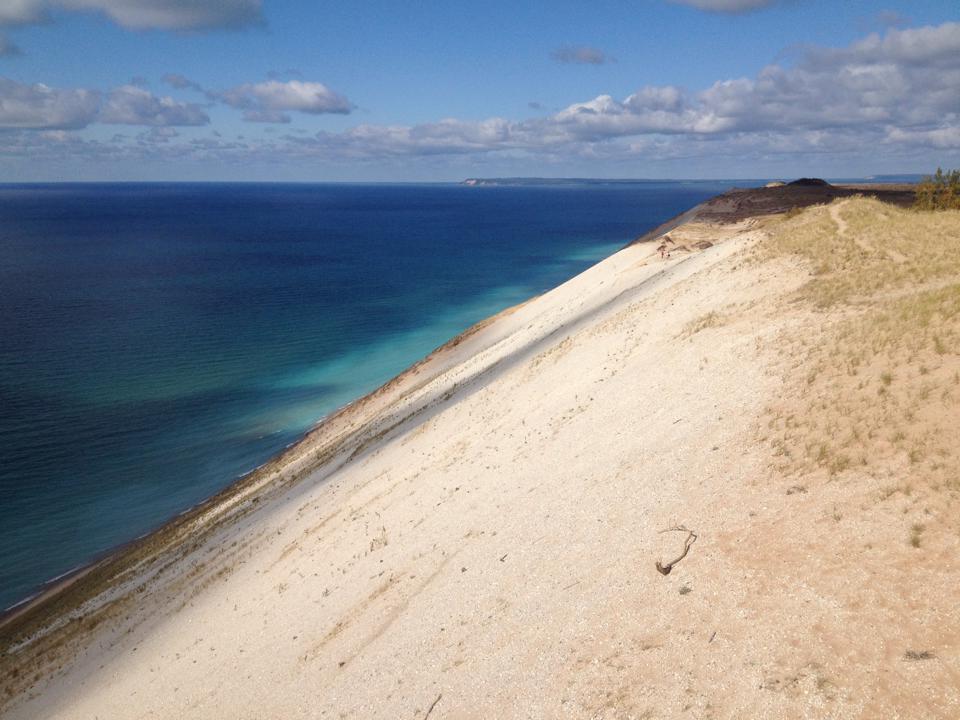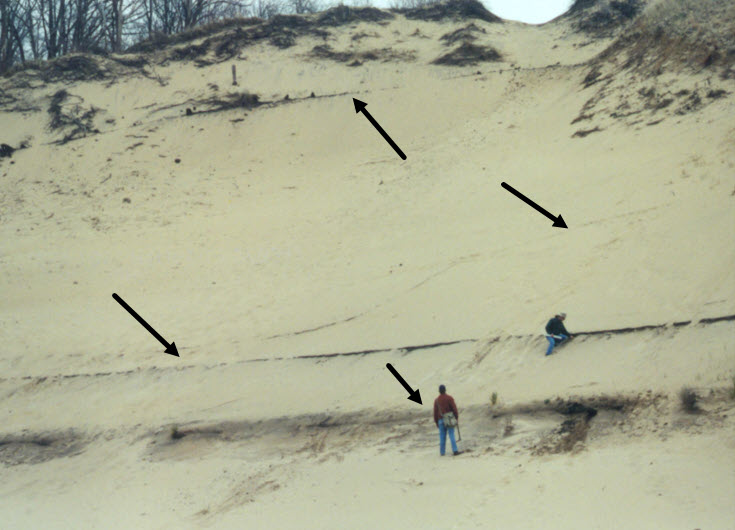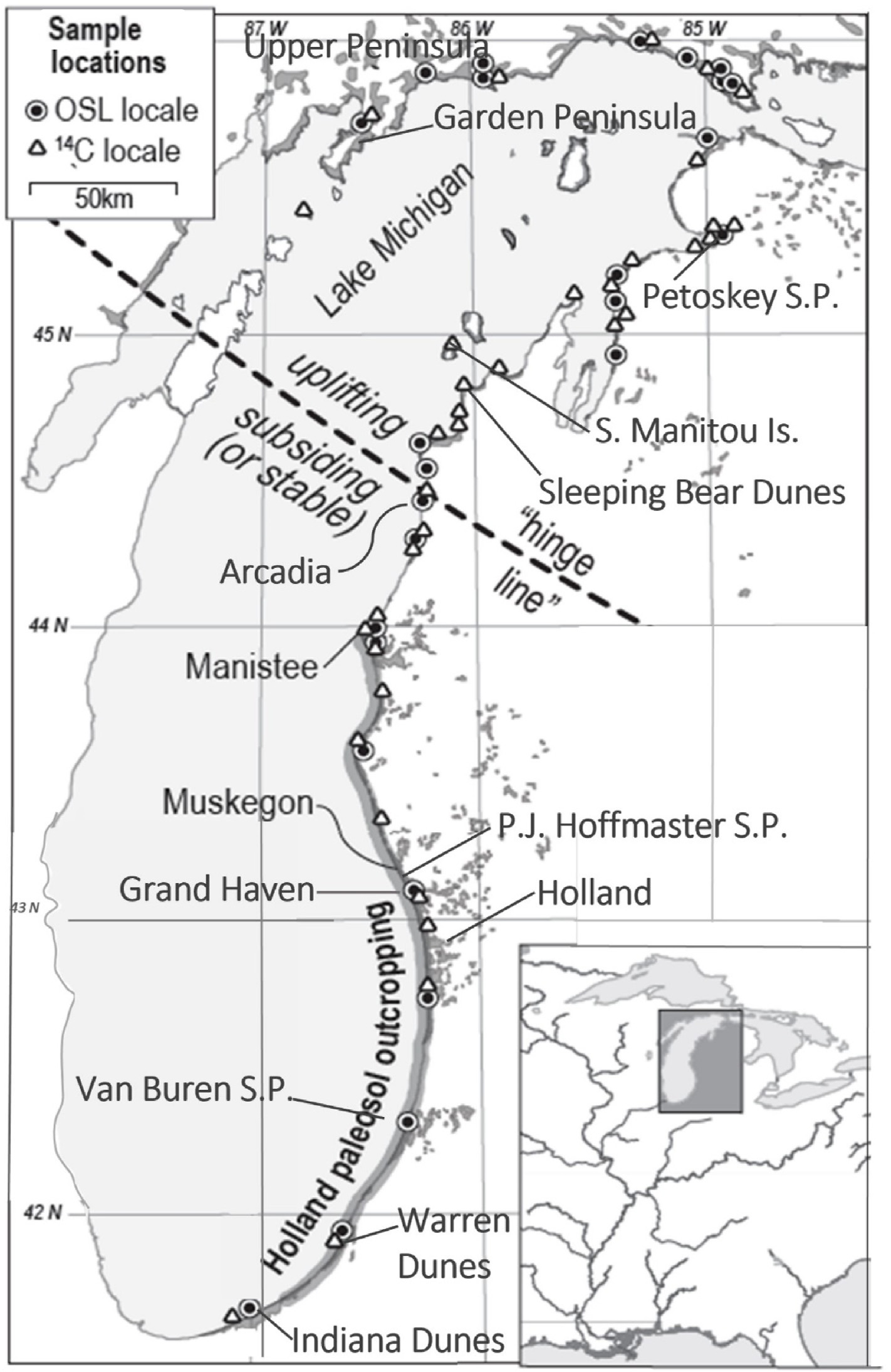MSU research rewrites the story of Lake Michigan's coastal dune evolution
June 5, 2023 - Diane Huhn
Great Lakes dune expert Alan Arbogast and colleagues shed new light on the region's dune formation

A scenic vista greets visitors at the Lake Michigan Overlook along the Pierce Stocking Scenic Drive at Sleeping Bear Dunes National Lakeshore. (Credit: Diane Huhn)
If you want to know how awe-inspiring the dunes of the Great Lakes region are, ask any Midwesterner about the first time they visited Sleeping Bear Dunes National Lakeshore. If you want to understand how and when those dynamic dunes evolved, ask Alan Arbogast—professor, coastal geomorphologist, and former chair of the Department of Geography, Environment and Spatial Sciences at Michigan State University.
In fact, you need look no further than Arbogast's official email address at MSU to get the hint that he is THE Great Lakes dune guy. Email addresses for most faculty members consist of some combination of their first and last names, sometimes with a few numbers thrown in, but Arbogast's is just DUNES. DUNES at MSU dot EDU. So let's just say that after spending the last 30+ years studying coastal dune evolution, especially the formation of those along the shores of Lake Michigan, Arbogast can rightly be called the guru of Great Lakes coastal dunes.

Now in a new publication appearing in Quaternary Science Reviews, one that he's affectionately dubbed his magnum opus about Michigan's dunes, Arbogast and his collaborators, Bill Lovis (archaeologist and Emeritus Professor of Anthropology), Kevin McKeehan (former Ph.D. student), and the late Bill Monaghan (geoarchaeologist formerly at Indiana University-Purdue University Indianapolis), have set out to comprehensively assess the evolution of dunes along Lake Michigan, and the role lake level fluctuations and climate have played in this 5,500-year history. "Research has been conducted on the Great Lakes dunes system for more than 100 years. We're not exactly sure how it happened, but it just kind of became accepted without any real testing that the dunes formed more or less during one interval of time, specifically during a period of high lake levels known as Nipissing high stand about 5,000 years ago," said Arbogast. "At first glance, that kind of made sense. Lake levels were about 15 feet higher than they are now, and people just thought that when the lake levels eventually dropped, there was a bunch of sand left all over, and the dunes just kind of blew up from that. But that just isn't the case."

Photograph of dune exposure at Van Buren State Park in 1999. The arrows point to buried soils in the dune. These soils represent periods of time when the dune wasn't growing as plant cover expanded, died, and was converted to organic remains that can be radiocarbon dated. This simple finding demonstrated that dunes grew in distinct stages rather than at one time (Photo credit: Ed Hansen, Hope College).
While conducting fieldwork at Van Buren State Park in 1999, Arbogast fortuitously happened upon a section of a dune that showed a series of distinctive soil layers buried within the dunes. It quickly became apparent to him that the dunes didn't form all at once; instead, they must have grown in distinct stages. Arbogast began exploring this new revelation with his collaborators Lovis and Monoghan. From that point on, the trio not only worked together for about two decades to help unravel this mystery, but they also became lifelong friends, although, unfortunately, Monaghan's life was cut short when he passed away in 2018.
"We initially thought the growth of the dunes was related simply to lake stages—that they had a tendency to grow during periods of high lake levels and then stabilized during periods of low lake levels. But we determined pretty quickly that that was overly simplistic," he said. "Then, about 15 years ago, we started thinking about patterns of storminess in the past, especially in relation to lake levels and the way sand was supplied to beaches. We thought if it were windier, that would cause the dunes to grow as sand moved from the beach inland."
About ten years ago, Arbogast began thinking about a new concept as it related to the formation of Great Lakes dunes—drought. "Until that point, drought was not really considered when discussing coastal dunes in the upper Midwest. The dunes of the Great Plains are drought dunes. Just think of the dust bowl. They're drought driven. They mobilize during dry episodes when plant cover shrinks and stabilize when wetter conditions prevail. But up to this point, it was always just accepted that Great Lakes dunes were driven mostly by fluctuations in the lakes and how they provided sand that could be blown into dunes," he explained. "After all, the Great Lakes region is more humid climatically than the Plains, and it seemed that drought would've played a fairly minimal role here."

Map of study area and Lake Michigan. Inset map in lower right corner shows location of the lake in the eastern United States. Larger map illustrates place names referenced in this study and position of sites where Carbon-14 and optical ages have been acquired. (Credit: G. William Monaghan)
As Arbogast and his colleagues continued to conduct research over the years, they collected many dozens of samples to test the age of the dunes. At the same time, a handful of other researchers in the area began conducting similar work. Many of the dates were obtained by radiocarbon dating organics in the buried soils they found. Numerous additional ages were acquired through incorporating an innovative dating technique known as optically stimulated luminescence (OSL), which involves determining the last time sand grains were exposed to light as they were blown and deposited by the wind. It started to become apparent that there were actually several periods of dune growth in the past rather than just the simple model of one major episode of growth previously believed.
This culminating research is based on a statistical analysis of the more than 250 total ages acquired from coastal dunes along Lake Michigan by all of the researchers working in the region. "After Bill Monaghan's unfortunate passing, Kevin McKeehan came on board to assist with this analysis," said Arbogast. According to Arbogast, "This analysis demonstrates that three major episodes of dune growth have occurred in the past 5,500 years. Of particular interest, and which is a new point of emphasis, is that these episodes align with periods of known drought in the region in addition to major lake-level fluctuations. The first active period of dune growth took place between about 5,000-4,000 years ago as the lake fell from the Nipissing high stand. This episode also correlates to the latter part of a geological era known as the mid-Holocene climate optimal. And we know that during this era, the Midwest was warmer than today and was experiencing doughty conditions".
Their analysis also determined that the second and third significant periods of dune growth, about 2,500 and 1,000 years ago, respectively, were also characterized by droughty periods, specifically the Roman Climate Optimum and Medieval Warm Period, respectively. "So, we've got these periods of dune growth that correspond to known periods of drought reconstructed by several great studies that have analyzed fossil pollen collected at the bottom of inland lakes. These studies demonstrate that as much as 20% less precipitation during these periods than today. So it really seems that drought is part of the story of our Great Lakes coastal dunes as well as lake-level fluctuations. We think that these relatively dry episodes might have pre-conditioned the dunes to mobilize and grow by reducing the cover of vegetation. And if it's true, then dunes along Lake Michigan are more similar to dunes out in the plains than we previously thought," said Arbogast.
What's next for the ongoing evolution of Lake Michigan's coastal dunes? Although it's impossible to say for sure, according to Arbogast, repeat photography of select sites and analysis of sequential satellite images shows that the dunes have been trending toward a less active period with expanding vegetation in the past century. "What's exciting for me is that when we think of the next 100 years of dune evolution, we may be entering a phase where the dunes are going to stabilize more and more. By stabilizing, I mean covered in plants. This means that sand won't be blowing around as much. When you couple that with human development, it's possible that our Great Lakes dunes may become kind of relic in the future with fewer patches of bare sand blowing around."
To learn more about this research, see "A 5500-year record of coastal dune evolution along the shores of Lake Michigan in the North American Great Lakes: The relationship of lake-level fluctuations and climate," published in Quaternary Science Reviews 307 (2023).

